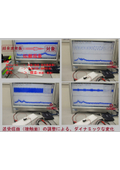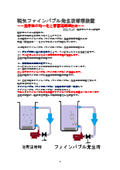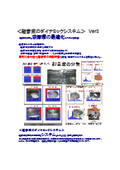Technical documentation on the use of fine bubbles (microbubbles) in ultrasonic applications - Deaeration fine bubble generation liquid circulation device.
Technology for stably utilizing fine bubbles with a spherical size of 20μm or less—nano-level cleaning method that controls acoustic flow of ultrasound—
1-1. Basics of Ultrasound
1-2. Propagation Phenomena of Ultrasonic Vibration
1-3. Fine Bubbles (Microbubbles)
*Properties of Microbubbles*
1) Bubbles of about 10μm rise slowly over approximately 3 hours to a height of 1m.
2) The generated bubbles exist independently without coalescing, resulting in excellent dispersion.
3) They have the property of slowly rising in water and adsorbing tiny debris to bring it to the surface.
...
13) The negative potential depends on the pH of the water.
14) Microbubbles have excellent scattering characteristics for ultrasound.
15) Microbubbles collapse as a resonance phenomenon when exposed to ultrasonic irradiation.
These properties are expected to be further elucidated in the future, but currently contain many unknown aspects.
Propagation Characteristics of Ultrasound
1) Detection of Vibration Modes (Changes in Self-Correlation)
2) Detection of Nonlinear Phenomena (Changes in Bicoherence)
3) Detection of Response Characteristics (Analysis of Impulse Response)
4) Detection of Interactions (Analysis of Power Contribution Rate)


Inquiry about this news
Contact Us OnlineMore Details & Registration
Details & Registration
Related Documents
Related Links
About Ultrasonic Cleaning Effects - No. 2
About Ultrasonic Cleaning
The Mechanism of Ultrasonic Cleaning and Effective Utilization Methods
Related product
Related catalog(25)














































